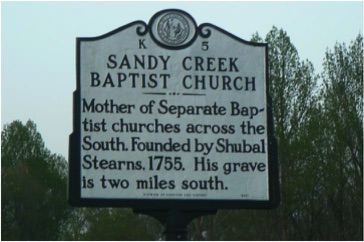
The Separate Baptist Revivals in the South,
1750-1790
Garry D. Nation

THE SEPARATE BAPTIST REVIVALS IN THE SOUTH, 1750-1790
A glowing firebrand was plucked from the cooling coals of New England's Great Awakening and touched to the dry tinder of the Southern colonies, igniting a new and distinct flame of revival. It was not a great, proud conflagration like its parent flame. It was rather like a running grassfire, catching here, burning wildly then dying out, but not before throwing sparks that would light up another spot. Beginning at the end of the First Great Awakening around 1750 and continuing through the beginnings of the Second Awakening around 1790 there was a flickering succession of revivals, varying in brightness, extent, and intensity at different times and locales but unquestionably unbroken.
This chain of awakenings of spiritual fervor and evangelistic zeal took place in the ranks of an inauspicious group who accepted the name Separate Baptists. Their growth throughout the South was phenomenally rapid, establishing a denominational preeminence in the region that has remained long after they united with other more “regular” Baptist groups and dropped the appellation “Separate.” According to Baptist historian William Lumpkin,
The accomplishments of the Separate Baptist movement are extremely remarkable since Baptists prior to 1755 were an insignificant and generally despised sect in America…. Yet they were destined in the providence of God to serve as chief instruments for planting the Christian faith along the southern frontier of early America.1
Their legacy for the Baptists who followed them, especially in the South, includes a heritage of revival. Other American denominations have experienced great revivals and have led the way in nationwide awakenings, but note has retained its revivalist influences so persistently as have the Baptists in the South. Perhaps a major reason is that no other denomination was forged in revival as they were. Revivalism—not only as an evangelistic methodology but also as an individual and communal openness to the personal work of the Holy Spirit—is part of the identity of the Baptists who trace their lineage to the Separates.
In defining and describing the revivalism of the Separate Baptists, I propose to show not merely how it facilitated their expansion but also reveal the unique character of their revivals. Along the way we will uncover and seek to answer a number of questions. Who were the Separate Baptists? Who were their leaders? What is it about their expansion that can be characterized as revival? How did their revival movement come about? What were the movement's antecedents, its attending effects, and its results? How did it spread? What problems were connected with it? How did it mature? How did the participants perceive what was happening? How was the movement perceived by its contemporaries? How should modern Baptists and Evangelicals perceive it? What can they learn from it about revival and spirituality, and what can they learn about their own identity?
In order to answer these questions, I will first trace the roots of the Separate Baptist movement to the preaching of British evangelist George Whitefield in the colonial Great Awakening. The movement itself will be considered in four (somewhat arbitrarily but still accurately designated) periods. Finally, I will discuss the overall character of the Separate Baptists revivals and how we may evaluate them.
I From the New England Origins of the Separate Baptists until 1755
II The Sandy Creek Church, 1755
III The Sandy Creek Association, 1758
IV The Period of Growth and Opposition, 1758-1771
V Division and Decline of Sandy Creek Association, 1770-1771
VI The Revolutionary Period, 1771-1781
VIII Assessing the Separate Baptist Movement
NOTES
1 William L. Lumpkin, Baptist Foundations in the South, reprinted in Colonial Baptists and Southern Revivals (NY: Arno Press, 1980), vi, vii.
